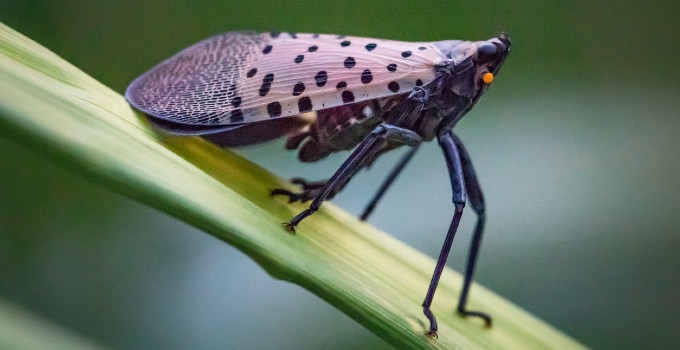Non-native insects can be challenging to control. Spotted lanternflies are one of the most troublesome pests currently plaguing Pennsylvania homes and businesses. With their numbers on the rise, several states have been put on alert for extreme watch. Why are spotted lanternflies such a problem? How can I tell if I have spotted lanternflies? The answers to these questions and more are here in Seitz Brothers’ guide to spotted lanternflies for Pennsylvania residents.
What do spotted lanternflies look like?
Spotted lanternflies are invasive insects, known as lycorma delicatula in the scientific community. They have five developmental stages progressing locally from hatching in mid-May through egg laying as late as December.
In their earlier stages, they are also noticeable. Each stage is called an instar. Their first instar begins right after hatching, and they look like black beetles dotted with white spots. During the second and third instar, they grow bigger and can vary in black or red shades. During their later adult stage, they lay eggs. This is problematic because those eggs keep these horrible creatures flying and hopping around Pennsylvania and other Mid-Atlantic states. Along with laying eggs, the adult stages are the most destructive. Even though the adults have wings, they do not fly well. Instead, they hop from plant to plant, and also to the hoods of nearby cars.
As adults, spotted lanternflies are very easy to identify due to their unique colors. They have grayish-brown wings decorated with black spots. The Pennsylvania Department of Agriculture provides clear identification: “The Spotted Lanternfly adult is approximately 1” long and 1/2” wide at rest. The forewing is grey with black spots and the wings tips are reticulated black blocks outlined in grey. The hind wings have contrasting patches of red and black with a white band. The legs and head are black; the abdomen is yellow with broad black bands. Immature stages are black with white spots, and develop red patches as they grow.”
Where do spotted lanternflies come from?
These invasive and destructive insects come from Asia, specifically China, Vietnam, and India. They arrived in Berks County, Pennsylvania, in 2014 when they were believed to have stowed away in a shipment from Asia. Their lack of natural predators has given them room to move all over Pennsylvania. Because significant control measures are proving to be near impossible, their spread is inevitable without the help of the public. By destroying their eggs, you can prevent future spotted lanternflies from hatching, thus putting an end to the cycle.
Why are spotted lanternflies so problematic?
Spotted lanternflies inflict irreversible damage to local crops and trees. They do not have enough native predators to make a dent in the population, which makes their control close to impossible. Spotted lanternflies move around the area quickly because they latch onto hard surfaces like car bodies so that they can move anywhere at any time.
The biggest problem with spotted lanternflies is their diet. Their feeding style damages the internal structure of plants. They use a penetrating mouth part to get into the sweet nectar of trees and fruit. This weakens plants and makes fruit inedible. Spotted lanternflies are attracted to crops that keep Pennsylvania farmers in business, such as apples as well as grapes, which hurts local wineries. After sucking the insides of plants and fruit, spotted lanternflies leave an excretion that attracts other insects, which causes more damage to the frail plants. The discharge also sticks to buildings and their exterior features.
Are spotted lanternflies dangerous?
Spotted lanternflies are incredibly destructive and can cause damage quickly because of their habit to collect in large numbers. Not only are they a threat to trees and ornamental foliage, but they also feed upon popular crops such as grapes and peaches, making it challenging for farmers to grow. Pennsylvania is also known for their attractive state parks and there is an immediate threat to these parks because of potential geographic expansion of populations if a spotted lanternfly were to stow away with a park visitor.
Fortunately, Pennsylvania can have a cold and frosty winter, which causes insects to go dormant. Spotted lanternflies remain in their eggs between fall and late spring. It is essential to destroy as many of them as possible during the egg and nymph stages.
Follow these easy steps to help prevent the spread of spotted lanternflies:
- Destroy egg masses if you find them.
- Report sightings to the Pennsylvania Department of Agriculture.
- Check your car for perched spotted lanternflies. If you find them, kill them immediately.
- Never leave a spotted lanternfly without killing them. Knocking down the population is your best defense.
To learn more about spotted lanternfly guidelines, click here.
How can Seitz Brothers get rid of spotted lanternflies?
Although we cannot fully eliminate spotted lanternflies on your property. We are able to assist in reducing the populations that would otherwise damage your trees. Give us a call or fill out the form on this page to learn more about our spotted lanternfly reduction services.
What are Spotted Lanternflies Pest Control in Pennsylvania & New Jersey A Closer Look at the Pest Plaguing Pennsylvania Homeowners and Businesses?
Serving Northeast & Central PA | Lehigh Valley | Pocono Mountains | Western NJ

